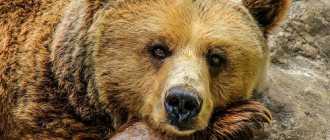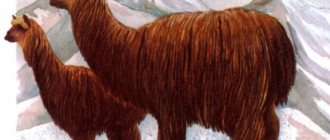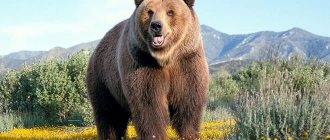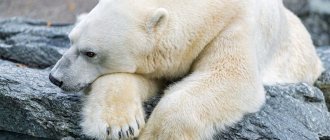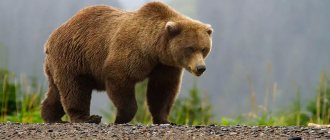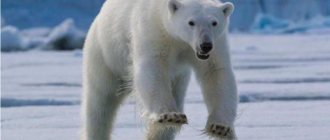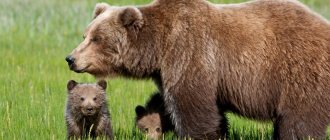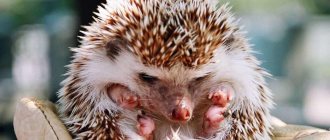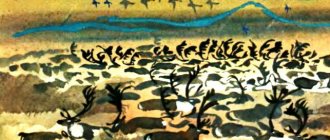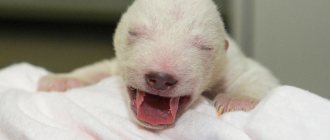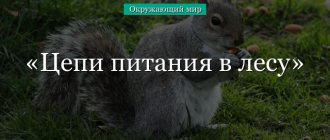Content
- 1 General description
- 2 Features of anatomy
- 3 Distribution
- 4 Lifestyle 4.1 Reproduction
- 7.1 Phylogenetics
- 10.1 In mythology and religion
Bears are not suitable for domestication
Over the last 10,000 years, humans have domesticated cats, dogs, pigs and cattle, so why haven't they domesticated bears, animals with which Homo sapiens have coexisted since the end of the Pleistocene era? As described in point No. 3, bears are solitary animals, so there is no room for a human owner who wishes to take a dominant position in the hierarchy. In addition, bears have such a varied diet that it would be difficult to adhere to, even with a well-tamed animal.
Perhaps most importantly, bears are restless and aggressive, so there are no suitable bears to keep in your home or yard as pets!
General description[ | ]
Compared to other families of the order of carnivores, bears are distinguished by the greatest uniformity of appearance, size, and many features of the internal structure. These are the largest of modern terrestrial predatory animals. Polar bears reach a body length of 3 meters and weigh up to 725 and even 890 kg; the Malayan bear is the smallest representative of the bear family: it does not exceed 1.5 meters in length, the height at the withers is only 50-70 cm; weight - 27-65 kg.
Males are 10-20% larger than females. In polar bears, the difference between males and females in size and weight reaches 1.5-2 times.
Fur with developed undercoat, rather coarse. The hairline is tall, sometimes shaggy; in most species it is thick, in the Malayan bear it is low and sparse. Seasonal dimorphism is expressed in changes in the height and density of fur. The color does not change by season, in most species it is uniform, from coal-black to whitish, in some species there is individual and geographical variability in color, pure brown bears have lighter markings on the chest or around the eyes, presumably this is an atavistic coloring from the first ancestor of bears. There are two examples of specific coloring - the giant panda has the most contrasting, black and white; The polar bear's hair is almost transparent, hollow, and in different directions of light it takes on a color from snow-white to golden (under certain medical circumstances it can even take on a purple hue).
Origin and characteristics of bears
Mammals belong to the group of canids. Today it has been established that animals can grow from 1.2 to 3 meters, their weight can vary from 40 kg to 1 ton. Some species are predators, while others feed on plants, berries and other delicacies. The average lifespan of an animal is 45 years.
There are several classifications of bears, which differ in the size of the animals, their habitat and other features. Let's look at some of them.
Features of anatomy[ | ]
All bears have stocky, powerful bodies, many with high withers.
The paws are strong, five-fingered, with large, non-retractable claws. The claws are controlled by powerful muscles, which allows bears to climb trees, as well as dig in the ground and tear apart prey. A grizzly bear's claws can reach 15 cm, which helps it dig the ground, but makes it impossible for it to climb trees. The bear's gait is shuffling and plantigrade. The giant panda and the spectacled bear have an additional, sixth “finger” on their front paws - an outgrowth of the radial sesamoid bone, covered with skin.
The tail is very short, invisible in the fur. The exception is the giant panda, whose tail is longer than that of other bears and is clearly visible from the outside.
The head is large, the eyes are small.
The neck is thick and relatively short.
Bears have a large skull, usually with an elongated facial section. The ridges on the skull are highly developed. The zygomatic arches are slightly spaced apart (in the Malayan bear - strongly). The polar bear differs sharply from others in the setting of the skull - the back of the head practically does not protrude. The jaws are powerful. A brown bear's bite force can reach 751 [3]. The incisors and canines are large, but the remaining teeth, due to the mixed type of nutrition, are small and not specialized (partially reduced). Teeth from 32 to 40-42. There is often individual and age-related variability in the dental system.
The sense of smell is highly developed, in some species it is comparable to that of a dog or even better; hearing and vision are weaker. Anal glands are often absent, or they are very poorly developed.
There is only one pair of nipples - the breast nipple.
How to deal with a bear
You can understand the presence of a bear in the territory by its tracks. This is a kidney-shaped crumb and five finger pads with claws. The animal also leaves marks on trees: abrasions or burrs on the trunk. Knowing that a bear is somewhere nearby, hunters should carefully choose a place to set up camp and not leave food on the ground. If you walk through the forest, talk loudly, make sounds, warn the bear about your presence.
If a meeting does occur, do not run away, but slowly move away in the opposite direction. If he follows, raise your bag up, increasing your height, shout loudly and sharply, you can use a firecracker or a whistle.
If the bear attacks, curl into a ball and cover your stomach and face with your hands. Don't move and play dead. Bears often lose interest in immobile prey.
Now you know what family bears belong to and how to behave correctly with such a predator. Be carefull!
Distribution[ | ]
Map of the distribution of various types of bears
Bears are found in Eurasia, North and South America (mainly in the Northern Hemisphere). The natural range of the family did not extend south further than the Atlas Mountains, the northwestern part of the Andes (South America) and the Malay Archipelago. Bears were common in Europe (including Iceland), Asia (except the Arabian Peninsula, Sulawesi and the Philippines), North America to central Mexico. The spectacled bear lives isolated in the mountainous regions of South America. In historical times, the range of the family was greatly reduced under the influence of anthropogenic changes in the natural environment - many bears disappeared from large areas of Europe and North America. Ursus live within the Russian Federation
.
Despite persistent rumors of human-bear encounters on the African continent (see separate article Nandi Bear), apparently there are no bears there.
Natural habitat
Brown bears were once distributed throughout the European continent. They also lived in the northwestern countries of Africa, and also lived in most of Asia. But now the population of these animals has decreased significantly, and in some places they have completely disappeared. And the reason for this was, of course, people who not only displace bears from their natural environment, but also continue to actively hunt them.
Bears are now rare in the wild
At the moment, the habitat of brown bears is limited to the following regions:
- Russia (except for the southern regions);
- Western Europe: Pyrenees, as well as the mountain systems of the Alps and Apennines;
- Central part of Europe;
- Spruce forests of the Ukrainian and Romanian Carpathians;
- Northern European countries – Finland and Norway;
- Western Asia, Palestine, Iran and Iraq;
- Northern China and Korean Peninsula;
- Highlands of Tibet;
- Himalayas and Tien Shan Pass;
- Hokkaido Island in Japan;
- Alaska, Canada and USA.
Lifestyle[ | ]
Spectacled bear
They live in a wide variety of conditions - from steppes to high mountains, from forests to arctic ice, and therefore differ in lifestyle and feeding methods. Most bears live in lowland or mountain forests of temperate and tropical latitudes, less often in treeless highlands. Some species are characterized by an attachment to water - both to streams and rivers, and to sea coasts. The polar bear inhabits the Arctic, right down to the ice fields of the Arctic Ocean. The common brown bear is found in the steppes and even in the desert, in subtropical forests, taiga, tundra and on sea coasts. All species are terrestrial animals. The polar bear is semi-aquatic. The Malayan bear is an excellent climber, leading a semi-arboreal lifestyle. Bears are active mainly at night, less often during the day or around the clock. The polar bear is primarily a diurnal animal. The rest period is spent in caves and holes at the roots of trees. The Malayan bear builds a kind of nest in the trees. They stay solitary, with the exception of pairs during the courtship period and females with young animals. They also gather in temporary groups at feeding areas, for example, on rivers during salmon runs.
They are omnivores by nature of nutrition, but some species prefer plant foods, others prefer animal foods. The polar bear feeds almost exclusively on the meat of marine mammals. Sloth and biruang destroy anthills and termite mounds. Giant pandas are specialized in eating bamboo shoots, but in addition to them they also consume some animal food. In the diet of almost all species, plant foods play an important role. Usually also eating insects and their larvae, fish and, less commonly, carrion. The diet often changes depending on the season and food availability.
Sloth bear
Most bears practice a sedentary lifestyle, but male polar bears roam widely throughout the year, and females with their young roam part of the year. The brown bear, Himalayan and baribal spend most of the winter in a den, in a state of hibernation (hibernation). During this period, they live off accumulated fat reserves. In polar bears, only pregnant females go into hibernation. Other species do not sleep in winter.
At first glance, bears are quite slow and clumsy, but sometimes they are able to run quite quickly (up to 50 km/h), climb, and rise on their hind legs. Some species are excellent swimmers. (The polar bear is a particularly good swimmer.) The visual acuity of some species is comparable to that of humans. The herbivorous baribal has color vision, allowing it to distinguish edible fruits and nuts by color. However, bears have the most developed sense of smell.
Reproduction[ | ]
Malayan bear
Bears breed from 3-4 years of age, but not annually, but at intervals of 1 to 4 years. The gestation period is short (60-70 days), but due to delayed implantation of the fertilized egg it can last up to 95-266 days. The number of cubs in a litter is from 1 to 5. Newborn cubs are blind and helpless, weighing only from 90 (giant panda) to 680 grams. In hibernating species, birth occurs in winter, in a den. Bears are monogamous, but pairs are short-lived and the male does not participate in caring for the offspring. Milk feeding lasts from 3.5 (Himalayan bear) to 9 (giant panda) months, but the young remain with the mother for at least 18 months. The older cubs staying with their mother help the mother take care of the younger brothers and sisters. They reach sexual maturity at the age of 3-6.5 years, but continue to grow until 5 (females) and 10-11 years (males).
Life expectancy is long, 25-40 years. A brown bear can live longer than 45 years in captivity. Some species, however, have high infant and adolescent mortality rates. Thus, in baribal, from 52% to 86% of young animals die before reaching sexual maturity. In polar bears, 10-30% of cubs and 3-16% of immature bears die. Adult bears have almost no natural enemies. Young ones run the risk of becoming victims of large predators or other bears.
What does a brown bear eat?
The main secret of the survival of brown bears is their omnivorous nature. Clubfoot predators are never averse to eating meat, and do not miss the opportunity to hunt herbivores that are found in their habitats. A bear is capable of killing an elk or a wild boar with one blow of its paw, but often agile prey manages to escape from the clumsy beast. Therefore, despite all their strength and power, bears mainly have to be content with plant foods.
The bear found a whole field of lingonberries
Recommended by topic
Fox Panda Lynx
The brown bear menu includes:
- Roots and tubers of plants, cones, nuts, acorns, young shoots and stems of herbs, mushrooms;
- Berries: raspberries, strawberries, lingonberries, blackberries, blueberries;
- Small animals, for example, hares, chipmunks, gophers, mice;
- Amphibians and reptiles (frogs, lizards);
- All kinds of insects: ants, worms, butterflies, beetles, as well as their larvae;
- Wild boars, elk, deer, roe deer.
During salmon spawning, the bear fattens up to its heart's content on fatty fish. And of course, he cannot resist his favorite delicacy - honey, and always destroys the nests of wild bees that he comes across.
Bears love fish very much
During lean seasons, when there are few grasses and edible roots in the forests, brown bears raid farmers' fields, eating oats and corn. They can also kill livestock by dragging the carcass of a goat or sheep into the forest and feeding on it for 3-4 days.
Role in the ecosystem[ | ]
All bears, due to their diet and large size, have a noticeable impact on the flora and fauna of their habitats. Brown and polar bears regulate populations of pinnipeds and ungulates. Herbivorous species facilitate the dispersal of plant seeds. Polar bears are often accompanied by arctic foxes, which eat the remains of their prey.
Large bears are at the top of the food chain. They have almost no natural enemies in nature. The tiger is the only predator that regularly hunts adult bears, including sloth bears, white-breasted bears, giant pandas, Malayan bears, and even small brown bears.
Polar bear
Bears are parasitized by a large number of endo- and exoparasites, including: protozoa ( Eimeria, Toxoplasma
), trematodes (
Nannophyetus salminicola
,
Neoricketsia helminthoeca
), cestodes (
Anacanthotaenia olseni, Mesocestoides krulli, Multiceps serialis, Taenia, Diphyllobothrium
), nematodes (
Baylisascaris transfuga, B. multipapillata, Uncinaria yukonensis, U. rauschi, Crenosoma, Thelazia californiensis, Dirofilaria ursi , Trichinella spiralis, Gongylonema pulchrum
), lice eaters (
Trichodectes pinguis
), fleas (
Chaetopsylla setosa, C. tuberculaticeps, Pulex irritans, Arctopsylla species
), ticks (
Dermacentor
and
Ixodes
).
The most common infection is trichinella ( Trichinella spiralis
), which affects up to 60% of the polar and brown bear population.
Hibernation of brown bears
Hibernation is one of the most important stages in the life of every brown bear. Indeed, during winter, such large predators simply have nothing to feed on, and nature itself took care of their survival, forcing the animals to spend a third of their lives in a state of sleep.
Bears living in the southern regions may not hibernate, although they also feed heavily in the summer, since in winter their diet is more meager and monotonous.
How a bear prepares for winter sleep
Preparation for hibernation in clubfooted animals begins at the end of summer, when forests and meadows are full of berries, mushrooms and edible plants. The bear intensively fattens its subcutaneous fat, eating everything it can find.
Before hibernation, the bear feeds intensively on any food
With the arrival of October, when the days become shorter and the nights become colder, the bear begins to look for suitable, and most importantly, safe shelter. Rock gorges and caves serve as their dens; these predators can dig holes or make depressions in a hole under a tree. The beast lines the bottom of its lair with moss and dry leaves so that it is dry, warm and cozy.
Period and duration of hibernation
The duration of hibernation lasts from several months to six months, and depends on weather conditions, as well as on the fact whether the bear managed to stock up on a sufficient amount of fat. Typically, clubfooted predators fall asleep in November-December and leave their wintering grounds in March-April.
Bear in his cozy winter den
During sleep, the metabolic processes in the bear's body slow down, the heart rate and breathing become more rare, which helps the animal save the fat resources it has accumulated with such difficulty.
Bear rod
Contrary to popular belief that you cannot wake up a hibernating bear even with a cannon salvo, these animals have light and shallow sleep. They may even wake up to look for a safer shelter, after which they fall asleep again.
Bear roar
But there are times when bears emerge from their sleep state in the middle of winter and begin to wander through the forest in search of food. Such animals are called “connecting rods,” and this happens if the animal did not have time to gain the fat necessary for the entire hibernation, and woke up from a feeling of hunger. Connecting bears are very aggressive; in search of food, they approach human dwellings and attack people without hesitation. Most of the predators that wake up ahead of schedule do not survive until spring, since they simply have nothing to feed on.
Meaning for humans[ | ]
The practical significance of the representatives of the family is small. The meat of many bears is edible. Bear fat and bile are used in medicine, including traditional Chinese medicine, to treat diseases of the liver and bile ducts, kidneys, and severe burns[4]. A bear is a subject of hunting; initially, bears were hunted with a spear. In some cases, bears can harm agricultural crops (most often oats, cassava) and beekeeping. Bears are favorite objects for keeping in zoos and for training, including circus training (a bear can be taught to ride a bicycle); in nature, a bear almost never attacks people first.
Numbers and ranges of all types of bears in the 20th century. sharply decreased, which required the introduction of restrictions on shooting and protection. The lists of the International Red Book include: giant panda, Himalayan, spectacled, polar bears and sloth bears.
The bear is a significant factor in Russian culture; it appears in many literary works, folk tales, epics, and sometimes as one of the main characters. Features in Russian proverbs and sayings. In heraldry, a bear, because it foresees the weather, knows how to hide in time in a den, where it prepares a lair for itself, is considered a symbol of foresight and is revered as passing (French passant) when walking, and rising (French leve) when standing on its hind legs .
Bears exhibit sexual dimorphism
Like their close relatives, seals and walruses, bears exhibit marked sexual dimorphism: males are significantly larger than females, and the larger the male, the greater the difference in size. (A male brown bear, for example, weighs about 500 kg, and females are only slightly more than half his weight.) However, even though females are smaller than males; They are not at all helpless and quite energetically protect the cubs from male bears, not to mention any such stupid individuals who decide to interfere in the process of raising cubs.
Male bears sometimes attack and kill cubs of their own species in order to encourage females to reproduce again.
Origin[ | ]
All mammals of the order Carnivora originate from a group of primitive marten-like predators known as miacidae
) and lived in the Paleocene - Eocene, giving rise to the ancestors of modern carnivores by the Oligocene.
Bears themselves belong to the suborder Caniformia
, whose representatives are believed to have descended from a common dog-like ancestor.
The origin of bears can be traced to Cephalogale
, a raccoon-sized animal that lived in the mid-Oligocene to early Miocene (20-30 million years ago) in Europe.
From it came the genus Ursavus
, predators the size of an average dog, whose fossil remains are known from the Middle Miocene deposits of Eurasia.
Giant panda
One of the early species, Ursavus elmensis
, about 20 million years ago, gave rise to the genera
Protursus
and
Pilonarctus
, from which true bears (
Ursus
) and representatives of the subfamily
Tremarctinae
.
The latter, in addition to the modern spectacled bear, included extinct genera: the Florida cave bear ( Tremarctos floridanus
) and North American short-faced bears (genus
Arctodus
).
The species Arctodus simus
and
Arctodus pristinus
are considered the largest among bears.
The largest number of genera and species of bears existed in the Pliocene in Eurasia and North America. The first true bear, Ursus minimus
, appeared approximately 5-6 million years ago;
This mammal, approximately the size of a Malayan bear, is known in fossil form in France (Roussillon). About 2.5 million years ago, a larger Etruscan bear appeared, Ursus etruscus
, known in fossil form not only in Europe, but also in China. From him, presumably, came the “black bears” - the baribal, as well as the Himalayan bear.
Larger forms of Ursus etruscus
, who lived ca.
1.5 million years ago, gave rise to modern brown and polar bears, as well as cave bears known since the Pleistocene: Ursus savini
(ca. 1 million years ago),
Ursus deningeri
(700 thousand years ago) and the cave bear
Ursus spelaeus
( 300 thousand years ago). During the Anthropocene, many bears (6-7 genera) became extinct[5][6].
The evolution of pandas has been less studied. Their ancestor, Agriarctos
, known from the Middle Miocene (3 million years ago).
Modern pandas Ailuropoda
(4 species) appeared at the beginning of the Pleistocene[7].
Phylogenetics[ | ]
Bears form a clade within Carnivores. The cladogram below is based on the molecular phylogenetics of six key genes according to Flynn, 2005.[8]
| Carnivora | |
| Caniformia | |
| Arctoidea | |
| Ursidae | |
| Musteloidea | |
| Other mustelids | |
There are two main phylogenetic hypotheses regarding the relationships between extant and fossil species of bears. According to the first, all species of bears are divided into seven subfamilies: Amphicynodontinae, Hemicyoninae, Ursavinae, Agriotheriinae, Ailuropodinae, Tremarctinae and Ursinae.[9][10][11][12] Below is a cladogram of ursidae subfamilies according to McLellan and Reiner (1992)[9] and Qiu et a. (2014):[12]
| Ursidae | |
| Ursinae | |
A second alternative hypothesis was developed by McKenna et al. (1997) - according to this hypothesis, all bear species are united in the superfamily Ursoidea
, while Hemicyoninae and Agriotheriinae belong to the family "Hemicyonidae".[13] Within this classification, Amphicynodontinae are considered to be the basal pinnipeds in the superfamily Phocoidea.[13] In McKenna and Bell's classification, both bears and pinnipeds are placed in the carnivorous suborder Ursida, along with the extinct "bear dogs" of the family Amphicyonidae.[13] Below is a cladogram based on the McKenna and Bell (1997) classification:[13]
| Ursida |
| Pinnipedia | |
| †Agriotheriinae | |
| Ursinae | |
The phylogenetic tree of extant bear species is presented in a cladogram based on mitochondrial DNA sequences from Yu et al., 2007.[14] The cladogram shows that the giant panda separated from the general tree earlier than the others, and the spectacled bears were next. The relationships between the remaining branches are not entirely clear, although it is clear that polar and brown bears are the closest relatives.[15]
| Ursidae | |
| Polar bear | |
| Baribal | |
Description of the animal
According to archaeologists, the species of brown bears descended from ancient martens many millions of years ago. The burials of ancient predators, the Malayan bear, were found on the territory of modern France.
Over the centuries, the animal varied from the small to the very large Etruscan bear. From this species came the brown bear, which later became the progenitor of many different subspecies.
The brown (ordinary) bear is one of the largest and most dangerous predators. In the wild, there are at least twenty subspecies of this animal, which differ in appearance and habitat.
The brown bear is a representative of the largest mammalian predators. It has impressive dimensions: up to 1.3 m at the withers and up to 2.5 m when standing on its hind legs.
The animal weighs up to 500 kg. However, there are also larger individuals weighing up to 700 kg.
What does it look like
Brown bears living on the European continent are relatively small. Their height is from one and a half to two meters, their body weight is no more than 250 kg.
Predators living in the central zone of the Russian Federation are smaller in size. They weigh about 120 kg. The largest species of brown bears are Far Eastern animals and grizzlies. Many animals reach a length of up to three meters.
Male bears are twice as large as females. They have a barrel-shaped body and massive withers. Quite powerful limbs have five fingers with huge non-retractable claws, their length is about 15 cm. The animal has a small round tail at the back, the size of which is no more than 20 cm.
Bears have a large head, a wide forehead, an elongated nose, small eyes and ears. The body is covered with thick, soft fur in brown or black color. The color depends on the region of residence, but most of the species are brown. Moulting in animals occurs once a year in the summer.
Systematics and evolution
The species of brown mammals belongs to the bear family. This is a group of large predators. Since small bears feed on breast milk, they are classified as mammals.
Type of bears - chordates, animal kingdom. Paleontologists, studying ancient fossilized remains of animals, came to the conclusion that today's bears evolved about 40 million years ago.
The ancestors were vegetarians, their homes were in trees, they were called miacids. From this type of animal, some groups were subsequently distinguished, bears were classified as one of them.
Animals of several groups (raccoons, dogs, bears) had a higher development than representatives of other species of mammals.
The entire animal world in the process of evolution became cunning, cautious, and it became more and more difficult to get prey. Therefore, representatives of these groups were able to survive thanks to the development of their intelligence.
Scientists believe that the most ancient creatures that could be classified as bears were predators the size of dogs. This animal lived on the European continent almost 20 million years ago.
Predators constantly evolved and began to look more and more like modern brown predators. Some were simply gigantic in size. However, many species have become extinct due to climate and habitat changes.
There are suggestions that the modern type originated from the small animal Protursus two million years ago. His predecessors developed along three lines and became:
- European. The representative of the species is the ancestor of the extinct cave bear.
- Two Asian ones. From them come real brown and black bears.
It is assumed that brown bears originally appeared in China. Then the geography of their habitat spread to Asia and Europe. During the Ice Age, animals became inhabitants of North America.
Character and lifestyle
Brown bears, despite their enormous size and natural clumsiness, are very fast in running, swimming and climbing trees. They have a developed sense of smell, which helps the animal sense prey at a distance of up to three hundred meters.
The animals are very neat and almost silent. They are solitary animals. The habitat is divided between adult predators. One male covers an area equal to 150 square kilometers. It is three times larger than the female's area. All individuals mark their territories with traces of urine and claw scratches on tree trunks.
Typically, predators avoid meeting people. But if they meet a hungry connecting rod or a mother bear with small cubs, the person is injured or the meeting ends in his death.
The most active time of wakefulness is early morning. At this time, the animal runs at a maximum speed of 55 km/h.
What does it eat?
The brown bear is an omnivore, but what it eats most is:
- berries;
- acorns;
- nuts;
- roots;
- tubers;
- plant stems;
- grass;
- cereals.
During crop failures, bears eat corn and oats and diversify their food:
- various insects;
- worms;
- lizards;
- frogs;
- field and forest rodents.
Adult big bears eat young artiodactyls as prey. The diet includes roe deer, fallow deer, deer, wild boar, and elk. The strong brown mammal can break the backbone of its prey with one paw. Then he pelts it with branches and vegetation, and stays nearby until he eats it all.
A subspecies of brown bear that lives near the sea feeds on seals, fish and seals.
Brown bears have excellent memories. They easily remember a place where a lot of berries or mushrooms grow and quickly find their way there.
In poor feeding years, food for large predators becomes domestic animals or livestock grazing on pastures.
Where it lives and distribution
Brown bears live in the vastness of the Russian Federation and are its symbol. But besides Russia, over the last century, Alaska, Canada, and European mountain territories have become the habitat of these huge, powerful predators. You can meet the brown predator on the Japanese islands and in Asian countries.
The largest brown individuals living in northern latitudes weigh from 700 kg to one ton. European species of small bears weigh from 500 to 600 kg.
Reproduction
The mating season of brown bears occurs in early May and lasts for two months. This is a time of fierce fighting and battles between males. The winning bear gets the right to the female, and the defeated rival is killed and eaten by the winner.
The female mates with several adults at once. Pregnancy develops during hibernation. The cubs appear after seven to eight months in the den. Usually these are two or three blind and deaf bear cubs, about a quarter of a meter tall and weighing up to 500 grams.
After the first two weeks of life, the cubs develop hearing and vision. They feed on their mother's milk and after three months, when the first teeth begin to appear, they can independently eat berries, vegetation, and insects. However, they are fed milk for one and a half years.
With the beginning of spring, the mother begins to release her children into the forest. If the kids sense danger, they quickly climb the tree. After four years of age, young individuals leave their mother. Full formation of a bear occurs at the age of 10 years.
The children live with their mother for four years. The father does not take part in raising the cubs. The female gives birth to babies once every two or three years.
Natural enemies
For a large, strong brown predator, the main enemy is humans and their activities. In the wild, it has virtually no other enemies. Few people can dare to attack a strong predatory beast.
Hunters shoot adults for its warm, beautiful skin, meat and bile. Poachers catch small bear cubs as an elite trophy. They are also then placed in zoos or nature reserves.
Animal meat is sold by poachers in the restaurant business. The skins are used as raw material for carpeting. In the pharmaceutical industry, animal fat and bile are in demand; they are used to make medicines.
The natural enemy of this predator in the wild is the mighty Ussuri tiger. When there is a fight against a tiger, the result can be the death of any animal.
Varieties
The various populations of brown bears are so large that they were previously divided into numerous distinct species. To date, all brown bears have been combined into one species with some geographical subspecies:
1. Common (European, Eurasian, Apennine). This subspecies lives in Europe and Asia. Colored yellow-brown, dark, or red-brown.
Predators with a powerful build, high at the withers, have strong lower limbs. The male weighs about half a ton, the females weigh no more than 250 kg.
2. California brown bear, or grizzly bear. The subspecies became extinct at the beginning of the 20th century. His image appears as a symbol on the California state flag. The grizzly bear was previously called the California golden bear.
It had a dominant role in the American ecosystem even before people settled it. During the period of Indians living on the American continent and white people appearing there, it was exterminated by them.
3. Siberian. Predators live in Siberia, in the east of the Yenisei River. Found in Eastern Kazakhstan and northern China. They are one of the largest brown bears. Weighs about 700 kg, reaches two meters in length, and up to one and a half meters at the withers.
They are muscular, have long and strong limbs and a massive head. The wool is colored dark brown. They are similar to the American grizzly bear.
4. Atlas. A subspecies of the brown predator lived in the Atlas Mountains in Morocco and Libya. At the end of the 19th century, the last animal was killed.
It had dark brown fur and a white spot on the muzzle, the underside of the body was colored with a reddish tint. The length of the fur reached 12 cm. The predator had a strong and massive body build. He ate roots, nuts and acorns.
5. Gobi. The habitat of the predators is the Gobi Desert in Mongolia. It is listed in the Red Book due to the critically small number of the population - only about thirty. They live in the Tsagan-Bogdo mountains, where only rare shrubs grow. Summer is spent near oases.
Living in the desert left a special imprint on the physiology of the individuals - small bears with a rare light brown or pale bluish coat color, decorated with a white stripe on the chest, throat and shoulders. They have light claws and fused second and third toes.
6. Mexican. A brown predator nicknamed the Mexican grizzly. Lived in southwest America, in the central regions of Mexico. The subspecies is considered extinct in the 60s of the last century. It was large in size: its length was about two meters and it weighed up to 350 kg.
The skin was colored pale brownish or grayish white. In bright sunlight it shone silver. In this regard, the Mexicans gave the animal the name “silver bear”. The body was decorated with long hair on the throat and sides. On the belly it was small; the sides and back did not have thick undercoat.
7. Tien Shan. Lives in the Himalayas, Palmyra, and Tien Shan. Refers to a sharply declining species. The brown mammal has small body length (1.5 m) and weight (300 kg). A distinctive feature of the bear is the presence of light claws on its front paws.
8. Ussuri (Japanese). Bears of this race are also called Japanese because of their habitat: the Far East, Sakhalin, the Japanese island of Hokkaido. It has an elongated skull, raised forehead, long nose and almost black fur. Animals are classified as vegetarians.
However, individuals living near water eat fish, insects, and birds. They also eat wood ants, larvae, and nuts. They have a peaceful character; a mother with small cubs can come close to people and will settle not far from them.
Thus, they protect babies from aggressive males and Ussuri tigers, for whom they are hunting prey.
9. Kodiak. Brown mammals native to Kodiak Island, Alaska. It is a very large predator living on land. It grows to enormous sizes (about 3m) and weighs more than 700 kg. The bear has a strong, muscular body, long powerful limbs and a huge head.
10. Tibetan (bear - pika-eater). Found on the Tibetan Plateau. Considered a rare mammal, it is extremely rare in the wild. It has medium sizes and a specific coat color:
- the dark brown back part is usually combined with the light front part;
- the chest and head are red, the withers are black;
- the muzzle is painted yellow, the chin and ears are dark brown;
- legs are black, claws are white.
This subspecies looks like a Yeti. The habitat of the animals has decreased significantly - if previously they were found in both Alaska and Mexico, today bears are on the verge of extinction.
11. Syriac. It is a separate species of brown bear. Lives in the countries of the Middle East, Libya, Syria, Turkey. Light-colored individuals reach a length of up to 150 cm.
Coat colors range from light brown to coffee. They live in mountain forests and on rocks. They are found in treeless areas and in cave crevices. Active in the early morning, late evening and at night.
Wintering and hibernation
Brown bears have a seasonal lifestyle. During the warm months, they actively move through thickets in forest areas. During the cold season, they sleep peacefully in their den.
In autumn, animals begin preparations for hibernation, the construction of dens and the accumulation of fatty tissue. Bears sleep from one to four or five months.
During hibernation, the animal’s vital signs do not change: heart rate, respiratory rate, blood pressure remain the same as during active wakefulness.
During hibernation, animals lose a lot of weight - about 70 kilograms. They are scrupulous in choosing a den, looking for secluded, quiet places. To make the bear warm and comfortable to sleep, he lines his shelter with moss.
The animals curl up in a ball in the den, pressing their hind legs to their stomach. The front ones are placed on the muzzle, covering the nose during sleep.
Sleep during hibernation is sensitive and shallow. The bear is easy to disturb and wake up in winter. The lifespan of an animal in nature is about 30 years, in a zoo up to 50 years.
Etymology of the word bear[ | ]
Baribal
Common Slavic word corresponding to Russian. bear
, in origin is a euphemism, which in everyday speech replaced the real taboo name of an animal [16].
This original name was not preserved in Slavic languages; the Indo-European name for the bear was *r̥ḱs-os/*r̥ḱt-os, giving Lat. ursus (from where in the Romanesque orso, ours
, etc.), Greek, Celtic, Hittite and Sanskrit names, and it itself may have been a euphemism in the Proto-Indo-European language[17].
bear
itself (from *
medu-
/
medv-
- “honey”, cf.
honey
+ *
ěd
- - “eat, eat”) means “eating honey”.
It is also worth paying attention to the attempt to bring the word bear closer to the Sanskrit madvadi
- “honey eating”, which, by the way, was not called a bear in Sanskrit[18].
The ban on pronouncing the real name was due to the fact that the bear was dangerous to humans (cf. taboo names for snakes in Indo-European languages). Later, the euphemistic replacement turned into the main name of the animal. The ancient custom was repeated at a new stage - even the current name of the bear, which was originally a euphemism, is again tabooed by Russians (especially hunters) and replaced with other euphemism nicknames: clubfoot, brown, potapych, Mikhailo, Mishka, owner,
etc. In a number of Slavic languages, this word is additionally distorted by permutations and substitutions of consonants, which, in addition to purely phonetic ones, can have a euphemistic nature: Ukrainian.
witch, Polish niedźwiedź, also in Czech in terms of dialects it is not medvěd
, but
nedvěd
(also became the surname Nedved). The word is borrowed from Slavic languages into Hungarian (Hungarian medve).
Euphemistic origin and Germanic name for a bear (German Bär, English bear, etc.); it goes back to the Proto-Germanic * beron
- “brown”.
den
from this name is considered erroneous[19].
For similar reasons, the Indo-European name was lost in the Baltic languages, where the original meaning of the name of this beast (Latvian lācis, lit. lokys, from * tlāk
, cf. Prussian
clokis
) is not entirely clear, cf. Slavic vollak (werewolf).
Pseudobears
The peasants of China called the giant panda a bear long before scientists. Some zoologists still classify the animal as a raccoon. The working people of the Celestial Empire always called the panda a bamboo bear. However, confusion arises because there is also a red panda.
Little panda
Unlike its big brother, it is classified as a panda. The verdict was also the result of genetic testing. It showed that the red panda is not related to bears or raccoons. The animal is similar in character to the latter.
The red panda is friendly and easy to tame. There are also external similarities with raccoons, for example, a tail, an elongated body, and sharp ears. The red panda resembles bears in its full-footed gait and, again, in its external features.
The size of a small panda is comparable to a large cat. Because of its dexterity in climbing trees, the animal is called a cat bear. The popular nickname cannot be changed, no matter what scientists say.
Koala
It is called a marsupial bear. The epithet in the name is true. The koala truly belongs to the marsupials, a class of protozoan mammals preserved only in Australia.
The name of the animal is similar to the name of the family to which it is assigned. There are no other members of the family. This, by the way, also applies to the red panda. She is also one of a kind.
The koala's closest relative is the wombat, and not a bear or even a red panda.
About 30 million years ago, 18 species of marsupial “bears” lived on the planet. There were also true club-footed people, unseen by modern man. Among them, 5-6 species became extinct.
Classification[ | ]
Extinct giant short-faced bear compared to humans Reconstruction of the cave bear
This small but widespread family includes only 8 modern species:
- † Subfamily Hemicyoninae † Adelpharctos
[10] - † Cephalogale
[11] - † Cyonarctos
[11] - † Dinocyon
- † Filholictis
[11] - † Hemicyon
- † Phoberocyon
- † Phoberogale
[11] - † Plithocyon
- † Zaragocyon
- Genus Ailuropoda - Giant pandas Ailuropoda melanoleuca - Giant panda
- † Allocyon
- Genus Tremarctos - Spectacled bears Tremarctos ornatus - Spectacled bear
- † Arctodus simus - Giant short-faced bear
- † Arctotherium brasilense
[20]
- Genus Helarctos - Malayan bears Helarctos malayanus - Malayan bear, or biruang
- Melursus ursinus [syn. Ursus ursinus
] - Sloth bear, or sloth bear
- Ursus arctos - Brown bear Ursus arctos arctos - European brown bear
- Ursus americanus kermodei - Kermode bear
] - Himalayan bear
Baribal, brown and polar bears interbreed and produce hybrids.
5. Bear (English “bear”) is a derivative of the ancient German word brown (“brown”)
Given that the population of medieval Europe did not have much contact with polar bears or pandas, it makes sense that peasants would associate the bears with their brown coloration – which originates from the Old Germanic word “bera”. Bears are also known as “ursines,” a word that has even older origins in Proto-Indo-European languages, being used as early as 3500 BC.
This obsession with bears is quite natural, given that the first settlers of Eurasia lived in close proximity to cave bears and sometimes worshiped these animals as gods.
Bear in culture[ | ]
Himalayan bear
In mythology and religion[ | ]
Main article: Cult of the bear
The bear appears in the myths of many peoples of Eurasia and America. In different traditions, he could be a deity, a cultural hero, a progenitor, a guardian spirit, the master of the lower world, etc.[21]
The cult of the bear existed among the Slavs (see above) and the Germans, among the indigenous peoples of the northern Urals, Siberia and the Far East. Among the Mansi, Kets and Nivkhs there was a widespread idea of the bear as the ancestor of people, and therefore the animal was especially revered; special rituals were carried out (in the classical form until the middle of the 20th century) designed to appease the soul of a totem killed during a hunt[22].
- Bear in Komi mythology.
In anthroponymy[ | ]
- The name Arthur is thought to be derived from the Welsh arth
, "bear". - Sveinbjorn is a Scandinavian name for "Bear Guy."
- Xiong - Chinese clan (surname) "bear".
- The female name Ursula comes from Lat. ursa, which means "bear".
In works of art[ | ]
Bears are heroes of fairy tales of various peoples of the world, stories, and are repeatedly mentioned in films.
Literature:
- "Three Bears"
- Winnie the Pooh A. A. Milna
- "The Jungle Book", D. R. Kipling - Baloo.
- "The Tales of Uncle Remus" by J. Harris - Brother Bear.
- “Oorfene Deuce and his wooden soldiers” and “Fiery God of the Marrans” by A. M. Volkov - a revived stuffed bear Topotun.
- "Bears Open Fire" is a short story by Terry Bisson, the plot of which is that bears open fire and start building fires on highways.
Cartoons:
- "Brother Bear"
- "Umka"
- "Hunting Season"
- "Forest Brotherhood"
- "Masha and the Bear"
- "Bear"
- "Kung Fu Panda"
- "Balto"
- Paddington Bear
In politics[ | ]
In modern political science (since the 19th century), the bear is considered a symbol of Russia.
- Albrecht Bear
- A russian bear
In stock trading[ | ]
On the stock exchange, a “bear” (as opposed to a “bull”) is a trader who plays to reduce the value of shares (ownership shares) of commercial organizations. As a rule, a “bear” has the goal of buying shares after they have fallen in price (or acquiring assets, the value of which is also guaranteed to decrease after a decrease in the value of the target security).
Other[ | ]
- Driving a bear - a Slavic rite
- Cult of the bear
- Sculptures of bears from the station in Vyborg
Bears on coats of arms and flags[ | ]
Main article: Bears on coats of arms and flags
- Coat of arms of Veliky Novgorod
- Coat of arms of the city of Yaroslavl
- Coat of arms of Perm
- Coat of arms of Berlin (Germany)
- Coat of arms of Greenland (Denmark)
- Coat of arms of Transcarpathia (Ukraine)
- Coat of arms of the Khabarovsk Territory
- Coat of arms of Khabarovsk
- Coat of arms of Norilsk
- Coat of arms of Syktyvkar
- Coat of arms of Mari El
- California flag
- Coat of arms of Karelia
- Coat of arms of Cherepovets
- Coat of arms of Sergach
- Coat of arms of Zheleznogorsk
A marching bear is depicted on the emblem of the United Russia party (formerly the Unity political movement). A similar image is found on the emblems of various companies - for example, the group [23].
Bears are extremely vocal animals
Depending on the species, a bear's basic communication needs can be expressed by seven or eight different "sounds" - snorting, chomping, groaning, roaring, woofing, growling, purring and coughing. As you may have guessed, the most dangerous sounds for humans are roars and growls, which indicate a frightened or excited animal defending its territory. A bear snorts, as a rule, during the breeding season. Purrs are used by cubs demanding attention from their mothers (the sound is a little similar to cats, but much louder), and moans express anxiety or a sense of danger.
Giant pandas have a slightly different vocabulary than their bear cousins; in addition to the sounds described above, they may also chirp, scream and moo.
Notes[ | ]
- Mammals of Russia: systematic and geographical reference book / Ed. I. Ya. Pavlinov and A. A. Lisovsky. - M.: Scientific T. KMK publications, 2012. - 604 p. — (Collected proceedings of the Zoological Museum of Moscow State University, vol. 52). — ISBN 978-87317-844-5.
- Brown bear (undefined)
. www.zoodrug.ru. Access date: July 14, 2016. - Wroe, Stephen;
McHenry, Colin; Thomason, Jeffrey. Bite club: comparative bite force in large biting mammals and the prediction of predatory behavior in fossil taxa // Proc. R. Soc. B. - 2005. - T. 272. - P. 619-625. - doi:10.1098/rspb.2004.2986. - Eastern medicine reveals its secrets Archived June 26, 2008 on the Wayback Machine.
- The Search Engine that Does at InfoWeb.net Archived June 17, 2006.
- The bear and cavebear in fact, myth and legend
- [1] (inaccessible link from 07/07/2013 [3123 days] - history
,
copy
) - Flynn, J. J.;
Finarelli, J. A.; Zehr, S.; Hsu, J.; Nedbal, MA Molecular phylogeny of the Carnivora (Mammalia): Assessing the impact of increased sampling on resolving enigmatic relationships (English) // Systematic Biology : journal. - 2005. - Vol. 54, no. 2. - P. 317-337. - doi:10.1080/10635150590923326. - PMID 16012099. - ↑ 1 2 McLellan, B.;
Reiner, DC A review of bear evolution (undefined) // International Association for Bear Research and Management. - 1992. - T. 9, No. 1. - P. 85-96. - doi:10.2307/3872687. - ↑ 1 2 L. de Bonis.
A new species of
Adelpharctos
(Mammalia, Carnivora, Ursidae) from the late Oligocene of the “Phosphorites du Quercy” (France) (English) // Estudios Geológicos: journal. - 2011. - Vol. 67, no. 2. - P. 179-186. - doi:10.3989/egeol.40553.181. - ↑ 1 2 3 4 5 Louis De Bonis.
Ursidae (Mammalia, Carnivora) from the Late Oligocene of the “Phosphorites du Quercy” (France) and a reappraisal of the genus
Cephalogale
Geoffroy, 1862 (English) // Geodiversitas: journal. — 2013. — Vol. 35, no. 4. - P. 787-814. - doi:10.5252/g2013n4a4. - ↑ 1 2 Qiu, Zhan-Xiang et al.
A Late Miocene
Ursavus
skull from Guanghe, Gansu, China (English) // Vertebrata PalAsiatica: journal. — 2014. — Vol. 52, no. 3. - P. 265-302. - ↑ 1 2 3 4 McKenna, M.C.;
Bell, S. Classification of Mammals Above the Species Level. - Columbia University Press, New York, 1997. - Yu, Li;
Li, Yi-Wei; Ryder, Oliver A.; Zhang, Ya-Ping. Analysis of complete mitochondrial genome sequences increases phylogenetic resolution of bears (Ursidae), a mammalian family that experienced rapid speciation (English) // BioMed Central (English) (Russian: journal. - 2007. - Vol. 7, no. 198. - doi:10.1186/1471-2148-7-198. - Servheen, C.
Bears: Status Survey and Conservation Action Plan / Servheen, C., Herrero, S., Peyton, B.. - IUCN, 1999. - P. 26–30. — ISBN 978-2-8317-0462-3. - A. A. Reformatsky “Introduction to linguistics” (§ 18 “Taboos and euphemisms”) // M. Aspect Press, 1997, ISBN 5-7567-0202-4
- Chernykh P. Ya.
Historical and etymological dictionary of the Russian language: in 2 volumes. T. 1. - M., 1991. - Nikolsky D.
Origin of the word
bear
Archival copy dated November 11, 2013 on the Wayback Machine // Philological notes. Voronezh. 1912. - Allegedly “the place where the ber lies,” see: M. Fasmer.
Etymological Dictionary of the Russian Language. T. 1. - M., 2004. P. 158. - The largest representative of the bear family has been identified. Archived copy dated February 7, 2011 on the Wayback Machine.
- Ivanov V.V.
,
Toporov V.N.
Bear // Myths of the peoples of the world. Encyclopedia: in 2 volumes. T. 2. - M.: Great Russian Encyclopedia, 2000. P. 128. - About this see: Alekseenko E. A.
Cult of the bear among the Kets // Soviet ethnography.
1960. No. 4. P. 90-104; Kreinovich E. A.
About the cult of the bear among the Nivkhs // Countries and Peoples of the East.
Vol. XXIV. - M., 1982. S. 244-283; Sokolova Z. P.
The cult of the bear and the bear holiday in the worldview and culture of the peoples of Siberia // Ethnographic Review.
2002. No. 1. P. 41-62; Tokarev S.A.
Remnants of totemism and the cult of the bear // Religion in the history of the peoples of the world. - M.: Politizdat, 1964. - Group website
